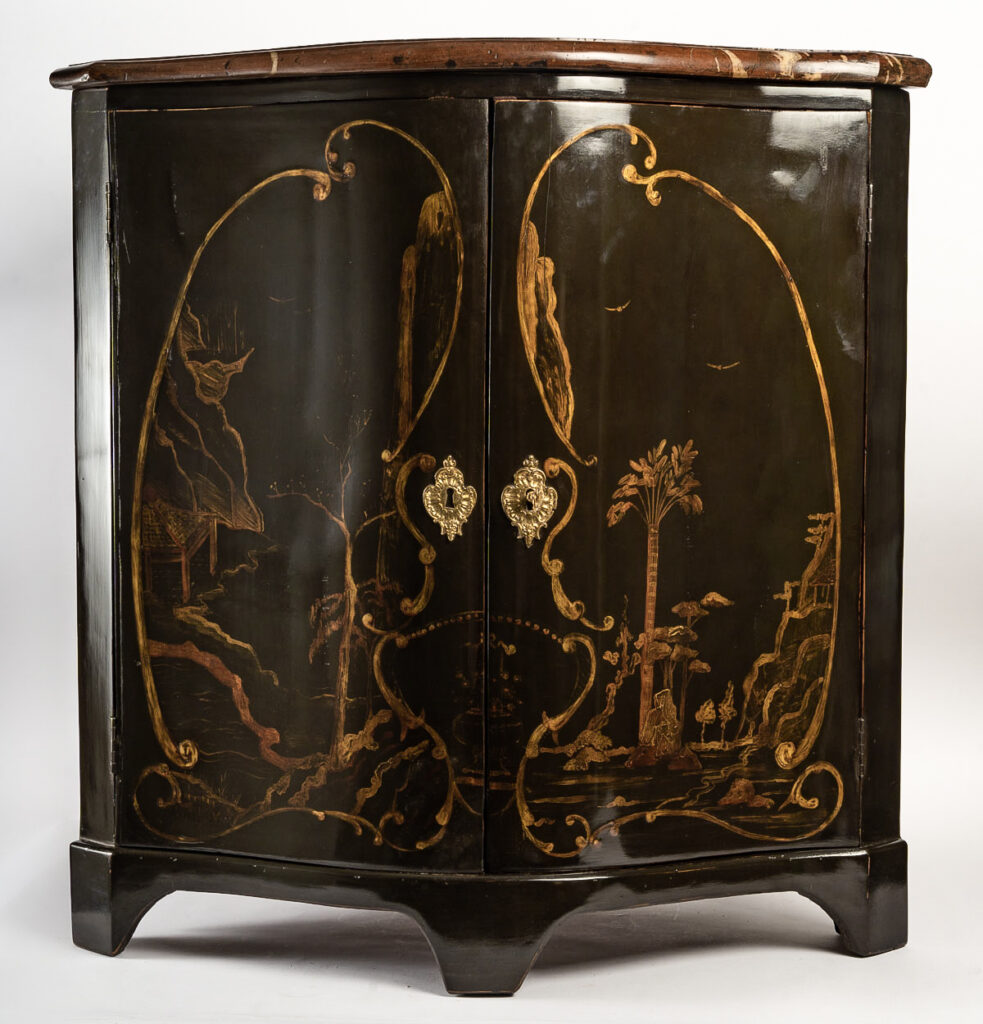J.C Ellaume & L Fortin Louis XV Period Cabinet-Corner in European Lacquer with Black and Gold Chinese Decoration
An elegant and decorative cabinet-corner with European lacquer decoration featuring a beautiful Chinese landscape on a black and gold background, embellished with trees, pagodas in a marine environment.
The corner in fir treated in the color Sang de Bœuf, receives on the curved doors the lacquer laminated. The furniture rests on a protruding plinth with three feet to ensure stability.
Our corner receives in the top part a Red marble of France with Bec de Corbin.
Beautiful French furniture of the Louis XV period, circa 1755-1760, with the stamp of Jean-Charles Ellaume and his mark JME of the Jurande des Menuisiers Ébénistes and stamped on the two upper amounts the stamp of L Fortin.
Dimensions : Hauteur 82 cm – Longueur 78 cm – Profondeur 54 cm.
In fine original condition, minor wear to the decoration, the iron hinges and bolts as well as the gilded bronze lock entries are of the original period. It should be noted that the lock is later and does not work at the moment. This corner is of a museum quality.
Who worked for whom : We can speculate that Jean-Charles Ellaume was at the origin of this piece of furniture, his biography attests that he sometimes realized works for orders of colleagues, he also realized pieces of furniture with this particular technique of the affixing of lacquers in front of the piece of furniture and a lot of furniture on protruding plinth. Finally, it is likely that he was the one controlled by the Jurande.
L. Fortin is less known, although today his furniture reaches important prices in auctions. Did he order lacquer furniture from his colleague, we can think so, with all the elements of biography that we have.
Jean-Charles Ellaume 1714-1763:
Sometimes called Allaume or Elleaume - is a French cabinetmaker of the XVIIIth century, received Master on November 6, 1754.
His workshop was located until 1775 on rue Traversière in the Faubourg Saint-Antoine district of Paris.
For more than thirty years, Jean-Charles Ellaume made many Louis XV, Regency and Louis XIV style chests of drawers. He uses the technique of frieze veneer. His workmanship is meticulous: a Regency period "tomb" chest of drawers with visible rails, small Louis XV chests of drawers with two drawers, also with visible rails.
His workshop also produced furniture for his fellow cabinetmakers, such as Léonard Boudin or Jean-Baptiste Tuart. This production is much less important but of greater quality than the chests of drawers that he produced for more than thirty years: beautiful flat desks provided with rocaille bronzes, rare chests of drawers and Louis XV corners decorated, on bottom of wood of pink, of very fine and very decorative marquetries of flowers, branches, musical instruments out of tinted wooden, in frames of foliage.
Henry Havard includes Ellaume in his list of cabinetmakers who made "works of a certain value from the year 1608 to the end of the Ancien Régime".
Jean Nicolay praises Ellaume in L’art et la Manière des Maîtres Ebénistes Français au XVIIIème Siècle: "His desks always have a harmonious line and excellent proportions. They are most often inlaid in Rosewood... The bronzes are always elegant and sober and discreetly provide a distinguished ornamentation. In sum, Ellaume was an excellent cabinetmaker who showed a perfect science of his art.
Museums and classed works of the cabinetmaker Jean-Charles Ellaume:
One of these chests of drawers, kept at the Château de Morlane, has been classed as a historical monument since 20 June 1979.
Two other chests of drawers are protected: a chest of drawers was listed on April 9, 2009 in the room known as Louise-Aimée's room at the Château de Vendeuvre and a chest of drawers was listed on July 29, 2011 at the Château de Gizeux.
The Bernay Museum of Fine Arts has several Ellaume chests of drawers in its permanent collection.
The Royal Castle of Wawel has commodes by Parisian cabinetmakers, including Ellaume, in its collections.
L. Fortin:
Rare stamp of the cabinetmaker Fortin. We know that he practiced in the capital during the French Louis XV period, and his productions, stamped "L. Fortin" - L. probably for "Louis" -, often show originality by their silhouette and their decorative motifs. This stamp is always found on quality furniture and on a limited production and only of Louis XV period.
Nowadays, his furniture is highly appreciated in sales and the prices to acquire them are sustained: a fine example of his elegant style, a flat desk of curved shape in rosewood veneer, resting on well arched legs, appeared in the sale of Maître Herbelin in Chinon and was appreciated up to €32.000.




